Contract and Negligence Act Report
VerifiedAdded on 2019/12/03
|12
|4063
|316
Report
AI Summary
This report provides a comprehensive analysis of contract law and negligence, covering essential elements for contract formation, different types of contracts, and various forms of contractual terms. It delves into real-world business scenarios, applying legal principles to cases involving offer, acceptance, and unilateral contracts. The report also explores the differences between tort and contractual liability, the nature of negligence, and employer's liability. Furthermore, it examines vicarious liability and defenses in tort cases, concluding with a summary of individual and employer responsibilities in legal contexts. The report includes references to various books, journals, and online resources.
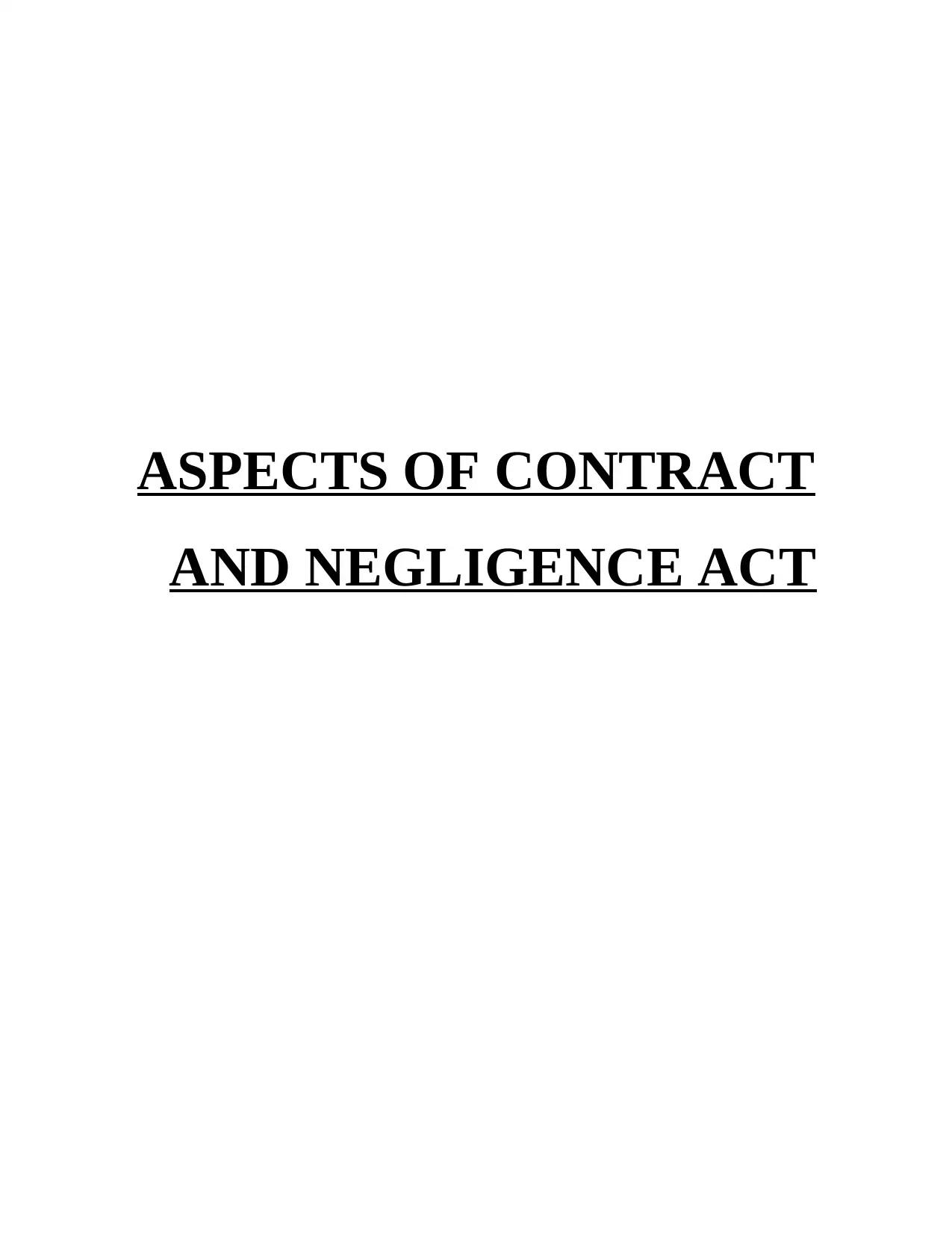
ASPECTS OF CONTRACT
AND NEGLIGENCE ACT
AND NEGLIGENCE ACT
Paraphrase This Document
Need a fresh take? Get an instant paraphrase of this document with our AI Paraphraser
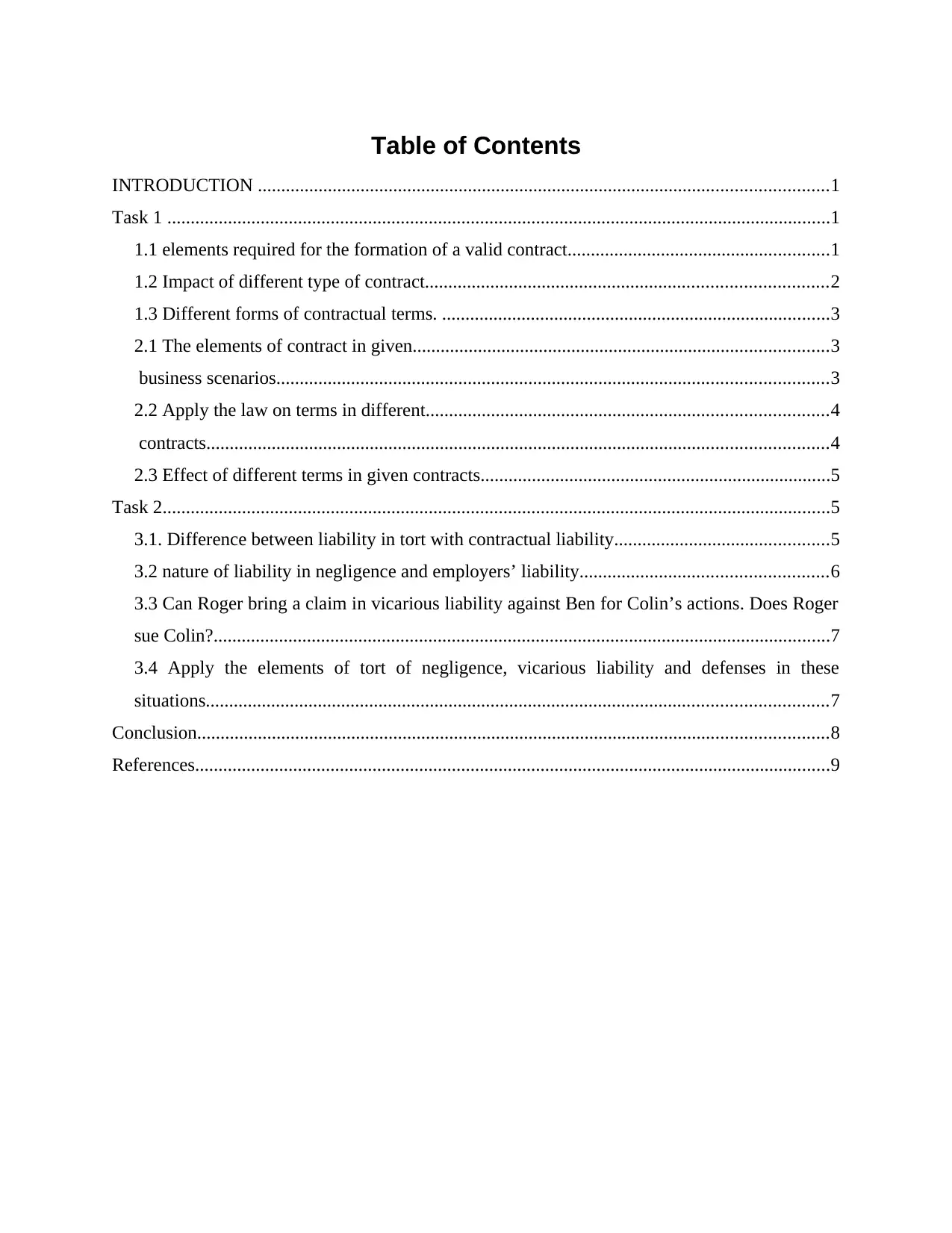
Table of Contents
INTRODUCTION ..........................................................................................................................1
Task 1 ..............................................................................................................................................1
1.1 elements required for the formation of a valid contract........................................................1
1.2 Impact of different type of contract......................................................................................2
1.3 Different forms of contractual terms. ...................................................................................3
2.1 The elements of contract in given.........................................................................................3
business scenarios......................................................................................................................3
2.2 Apply the law on terms in different......................................................................................4
contracts.....................................................................................................................................4
2.3 Effect of different terms in given contracts...........................................................................5
Task 2...............................................................................................................................................5
3.1. Difference between liability in tort with contractual liability..............................................5
3.2 nature of liability in negligence and employers’ liability.....................................................6
3.3 Can Roger bring a claim in vicarious liability against Ben for Colin’s actions. Does Roger
sue Colin?....................................................................................................................................7
3.4 Apply the elements of tort of negligence, vicarious liability and defenses in these
situations.....................................................................................................................................7
Conclusion.......................................................................................................................................8
References........................................................................................................................................9
INTRODUCTION ..........................................................................................................................1
Task 1 ..............................................................................................................................................1
1.1 elements required for the formation of a valid contract........................................................1
1.2 Impact of different type of contract......................................................................................2
1.3 Different forms of contractual terms. ...................................................................................3
2.1 The elements of contract in given.........................................................................................3
business scenarios......................................................................................................................3
2.2 Apply the law on terms in different......................................................................................4
contracts.....................................................................................................................................4
2.3 Effect of different terms in given contracts...........................................................................5
Task 2...............................................................................................................................................5
3.1. Difference between liability in tort with contractual liability..............................................5
3.2 nature of liability in negligence and employers’ liability.....................................................6
3.3 Can Roger bring a claim in vicarious liability against Ben for Colin’s actions. Does Roger
sue Colin?....................................................................................................................................7
3.4 Apply the elements of tort of negligence, vicarious liability and defenses in these
situations.....................................................................................................................................7
Conclusion.......................................................................................................................................8
References........................................................................................................................................9
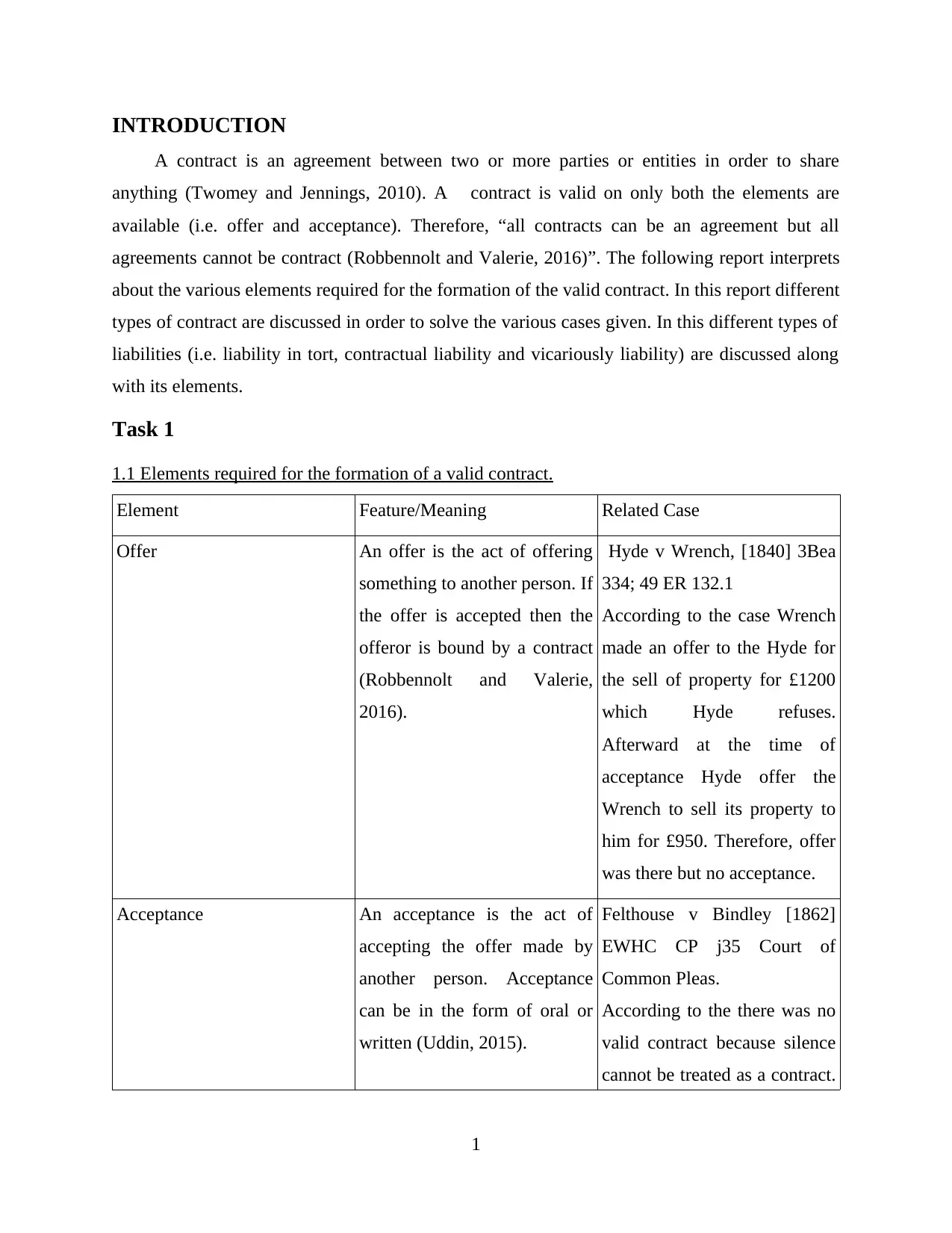
INTRODUCTION
A contract is an agreement between two or more parties or entities in order to share
anything (Twomey and Jennings, 2010). A contract is valid on only both the elements are
available (i.e. offer and acceptance). Therefore, “all contracts can be an agreement but all
agreements cannot be contract (Robbennolt and Valerie, 2016)”. The following report interprets
about the various elements required for the formation of the valid contract. In this report different
types of contract are discussed in order to solve the various cases given. In this different types of
liabilities (i.e. liability in tort, contractual liability and vicariously liability) are discussed along
with its elements.
Task 1
1.1 Elements required for the formation of a valid contract.
Element Feature/Meaning Related Case
Offer An offer is the act of offering
something to another person. If
the offer is accepted then the
offeror is bound by a contract
(Robbennolt and Valerie,
2016).
Hyde v Wrench, [1840] 3Bea
334; 49 ER 132.1
According to the case Wrench
made an offer to the Hyde for
the sell of property for £1200
which Hyde refuses.
Afterward at the time of
acceptance Hyde offer the
Wrench to sell its property to
him for £950. Therefore, offer
was there but no acceptance.
Acceptance An acceptance is the act of
accepting the offer made by
another person. Acceptance
can be in the form of oral or
written (Uddin, 2015).
Felthouse v Bindley [1862]
EWHC CP j35 Court of
Common Pleas.
According to the there was no
valid contract because silence
cannot be treated as a contract.
1
A contract is an agreement between two or more parties or entities in order to share
anything (Twomey and Jennings, 2010). A contract is valid on only both the elements are
available (i.e. offer and acceptance). Therefore, “all contracts can be an agreement but all
agreements cannot be contract (Robbennolt and Valerie, 2016)”. The following report interprets
about the various elements required for the formation of the valid contract. In this report different
types of contract are discussed in order to solve the various cases given. In this different types of
liabilities (i.e. liability in tort, contractual liability and vicariously liability) are discussed along
with its elements.
Task 1
1.1 Elements required for the formation of a valid contract.
Element Feature/Meaning Related Case
Offer An offer is the act of offering
something to another person. If
the offer is accepted then the
offeror is bound by a contract
(Robbennolt and Valerie,
2016).
Hyde v Wrench, [1840] 3Bea
334; 49 ER 132.1
According to the case Wrench
made an offer to the Hyde for
the sell of property for £1200
which Hyde refuses.
Afterward at the time of
acceptance Hyde offer the
Wrench to sell its property to
him for £950. Therefore, offer
was there but no acceptance.
Acceptance An acceptance is the act of
accepting the offer made by
another person. Acceptance
can be in the form of oral or
written (Uddin, 2015).
Felthouse v Bindley [1862]
EWHC CP j35 Court of
Common Pleas.
According to the there was no
valid contract because silence
cannot be treated as a contract.
1
⊘ This is a preview!⊘
Do you want full access?
Subscribe today to unlock all pages.

Trusted by 1+ million students worldwide
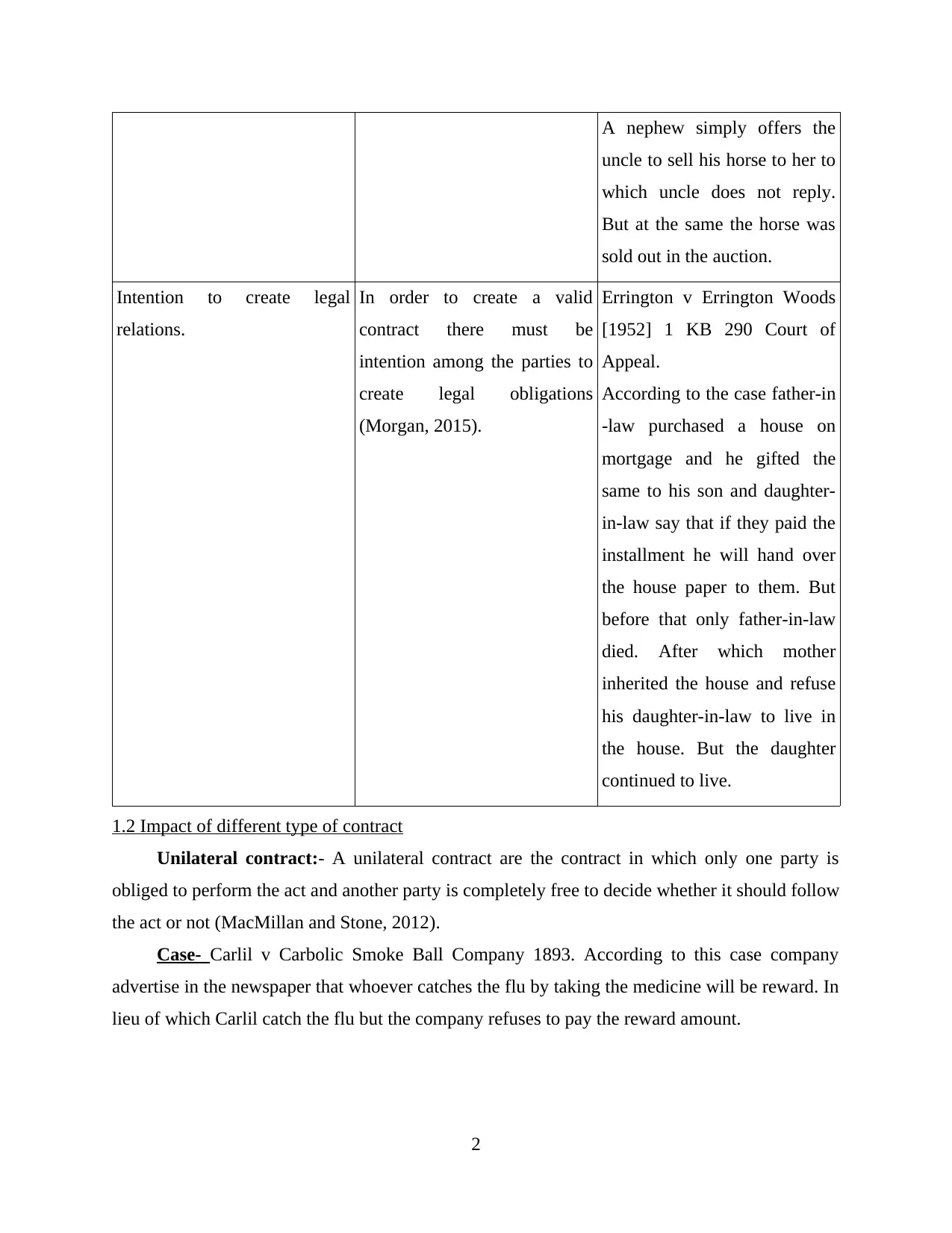
A nephew simply offers the
uncle to sell his horse to her to
which uncle does not reply.
But at the same the horse was
sold out in the auction.
Intention to create legal
relations.
In order to create a valid
contract there must be
intention among the parties to
create legal obligations
(Morgan, 2015).
Errington v Errington Woods
[1952] 1 KB 290 Court of
Appeal.
According to the case father-in
-law purchased a house on
mortgage and he gifted the
same to his son and daughter-
in-law say that if they paid the
installment he will hand over
the house paper to them. But
before that only father-in-law
died. After which mother
inherited the house and refuse
his daughter-in-law to live in
the house. But the daughter
continued to live.
1.2 Impact of different type of contract
Unilateral contract:- A unilateral contract are the contract in which only one party is
obliged to perform the act and another party is completely free to decide whether it should follow
the act or not (MacMillan and Stone, 2012).
Case- Carlil v Carbolic Smoke Ball Company 1893. According to this case company
advertise in the newspaper that whoever catches the flu by taking the medicine will be reward. In
lieu of which Carlil catch the flu but the company refuses to pay the reward amount.
2
uncle to sell his horse to her to
which uncle does not reply.
But at the same the horse was
sold out in the auction.
Intention to create legal
relations.
In order to create a valid
contract there must be
intention among the parties to
create legal obligations
(Morgan, 2015).
Errington v Errington Woods
[1952] 1 KB 290 Court of
Appeal.
According to the case father-in
-law purchased a house on
mortgage and he gifted the
same to his son and daughter-
in-law say that if they paid the
installment he will hand over
the house paper to them. But
before that only father-in-law
died. After which mother
inherited the house and refuse
his daughter-in-law to live in
the house. But the daughter
continued to live.
1.2 Impact of different type of contract
Unilateral contract:- A unilateral contract are the contract in which only one party is
obliged to perform the act and another party is completely free to decide whether it should follow
the act or not (MacMillan and Stone, 2012).
Case- Carlil v Carbolic Smoke Ball Company 1893. According to this case company
advertise in the newspaper that whoever catches the flu by taking the medicine will be reward. In
lieu of which Carlil catch the flu but the company refuses to pay the reward amount.
2
Paraphrase This Document
Need a fresh take? Get an instant paraphrase of this document with our AI Paraphraser
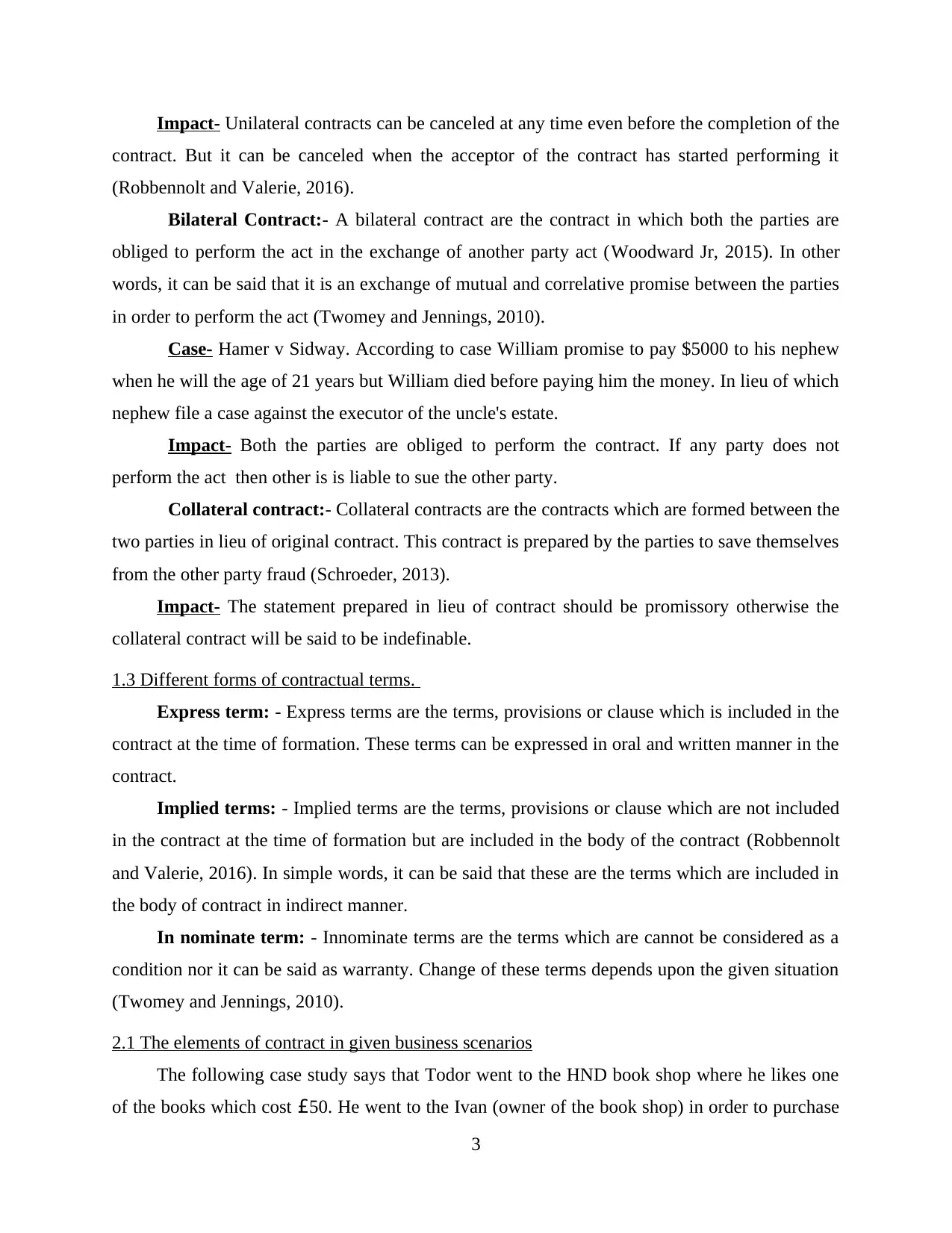
Impact- Unilateral contracts can be canceled at any time even before the completion of the
contract. But it can be canceled when the acceptor of the contract has started performing it
(Robbennolt and Valerie, 2016).
Bilateral Contract:- A bilateral contract are the contract in which both the parties are
obliged to perform the act in the exchange of another party act (Woodward Jr, 2015). In other
words, it can be said that it is an exchange of mutual and correlative promise between the parties
in order to perform the act (Twomey and Jennings, 2010).
Case- Hamer v Sidway. According to case William promise to pay $5000 to his nephew
when he will the age of 21 years but William died before paying him the money. In lieu of which
nephew file a case against the executor of the uncle's estate.
Impact- Both the parties are obliged to perform the contract. If any party does not
perform the act then other is is liable to sue the other party.
Collateral contract:- Collateral contracts are the contracts which are formed between the
two parties in lieu of original contract. This contract is prepared by the parties to save themselves
from the other party fraud (Schroeder, 2013).
Impact- The statement prepared in lieu of contract should be promissory otherwise the
collateral contract will be said to be indefinable.
1.3 Different forms of contractual terms.
Express term: - Express terms are the terms, provisions or clause which is included in the
contract at the time of formation. These terms can be expressed in oral and written manner in the
contract.
Implied terms: - Implied terms are the terms, provisions or clause which are not included
in the contract at the time of formation but are included in the body of the contract (Robbennolt
and Valerie, 2016). In simple words, it can be said that these are the terms which are included in
the body of contract in indirect manner.
In nominate term: - Innominate terms are the terms which are cannot be considered as a
condition nor it can be said as warranty. Change of these terms depends upon the given situation
(Twomey and Jennings, 2010).
2.1 The elements of contract in given business scenarios
The following case study says that Todor went to the HND book shop where he likes one
of the books which cost £50. He went to the Ivan (owner of the book shop) in order to purchase
3
contract. But it can be canceled when the acceptor of the contract has started performing it
(Robbennolt and Valerie, 2016).
Bilateral Contract:- A bilateral contract are the contract in which both the parties are
obliged to perform the act in the exchange of another party act (Woodward Jr, 2015). In other
words, it can be said that it is an exchange of mutual and correlative promise between the parties
in order to perform the act (Twomey and Jennings, 2010).
Case- Hamer v Sidway. According to case William promise to pay $5000 to his nephew
when he will the age of 21 years but William died before paying him the money. In lieu of which
nephew file a case against the executor of the uncle's estate.
Impact- Both the parties are obliged to perform the contract. If any party does not
perform the act then other is is liable to sue the other party.
Collateral contract:- Collateral contracts are the contracts which are formed between the
two parties in lieu of original contract. This contract is prepared by the parties to save themselves
from the other party fraud (Schroeder, 2013).
Impact- The statement prepared in lieu of contract should be promissory otherwise the
collateral contract will be said to be indefinable.
1.3 Different forms of contractual terms.
Express term: - Express terms are the terms, provisions or clause which is included in the
contract at the time of formation. These terms can be expressed in oral and written manner in the
contract.
Implied terms: - Implied terms are the terms, provisions or clause which are not included
in the contract at the time of formation but are included in the body of the contract (Robbennolt
and Valerie, 2016). In simple words, it can be said that these are the terms which are included in
the body of contract in indirect manner.
In nominate term: - Innominate terms are the terms which are cannot be considered as a
condition nor it can be said as warranty. Change of these terms depends upon the given situation
(Twomey and Jennings, 2010).
2.1 The elements of contract in given business scenarios
The following case study says that Todor went to the HND book shop where he likes one
of the books which cost £50. He went to the Ivan (owner of the book shop) in order to purchase
3
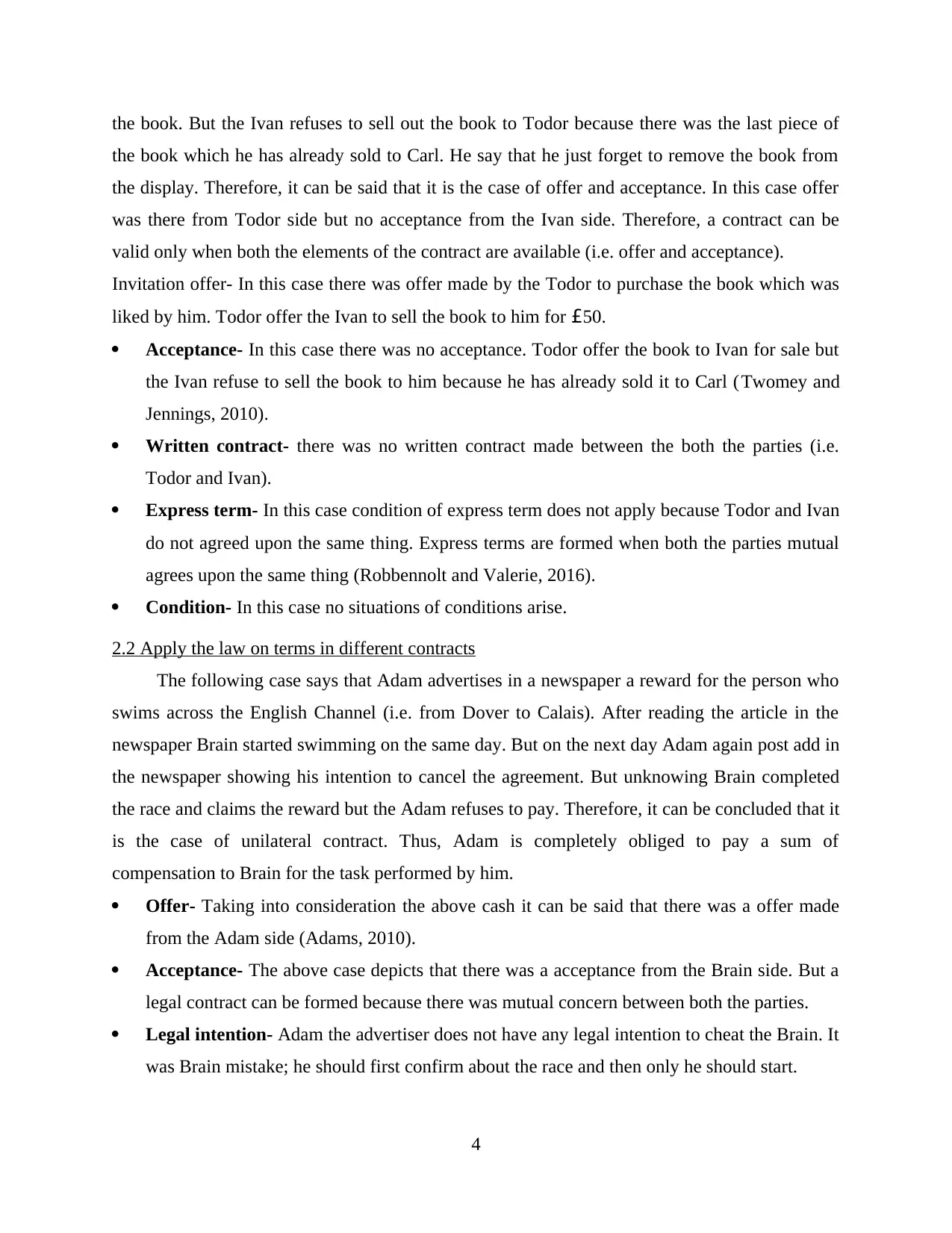
the book. But the Ivan refuses to sell out the book to Todor because there was the last piece of
the book which he has already sold to Carl. He say that he just forget to remove the book from
the display. Therefore, it can be said that it is the case of offer and acceptance. In this case offer
was there from Todor side but no acceptance from the Ivan side. Therefore, a contract can be
valid only when both the elements of the contract are available (i.e. offer and acceptance).
Invitation offer- In this case there was offer made by the Todor to purchase the book which was
liked by him. Todor offer the Ivan to sell the book to him for £50.
Acceptance- In this case there was no acceptance. Todor offer the book to Ivan for sale but
the Ivan refuse to sell the book to him because he has already sold it to Carl (Twomey and
Jennings, 2010).
Written contract- there was no written contract made between the both the parties (i.e.
Todor and Ivan).
Express term- In this case condition of express term does not apply because Todor and Ivan
do not agreed upon the same thing. Express terms are formed when both the parties mutual
agrees upon the same thing (Robbennolt and Valerie, 2016).
Condition- In this case no situations of conditions arise.
2.2 Apply the law on terms in different contracts
The following case says that Adam advertises in a newspaper a reward for the person who
swims across the English Channel (i.e. from Dover to Calais). After reading the article in the
newspaper Brain started swimming on the same day. But on the next day Adam again post add in
the newspaper showing his intention to cancel the agreement. But unknowing Brain completed
the race and claims the reward but the Adam refuses to pay. Therefore, it can be concluded that it
is the case of unilateral contract. Thus, Adam is completely obliged to pay a sum of
compensation to Brain for the task performed by him.
Offer- Taking into consideration the above cash it can be said that there was a offer made
from the Adam side (Adams, 2010).
Acceptance- The above case depicts that there was a acceptance from the Brain side. But a
legal contract can be formed because there was mutual concern between both the parties.
Legal intention- Adam the advertiser does not have any legal intention to cheat the Brain. It
was Brain mistake; he should first confirm about the race and then only he should start.
4
the book which he has already sold to Carl. He say that he just forget to remove the book from
the display. Therefore, it can be said that it is the case of offer and acceptance. In this case offer
was there from Todor side but no acceptance from the Ivan side. Therefore, a contract can be
valid only when both the elements of the contract are available (i.e. offer and acceptance).
Invitation offer- In this case there was offer made by the Todor to purchase the book which was
liked by him. Todor offer the Ivan to sell the book to him for £50.
Acceptance- In this case there was no acceptance. Todor offer the book to Ivan for sale but
the Ivan refuse to sell the book to him because he has already sold it to Carl (Twomey and
Jennings, 2010).
Written contract- there was no written contract made between the both the parties (i.e.
Todor and Ivan).
Express term- In this case condition of express term does not apply because Todor and Ivan
do not agreed upon the same thing. Express terms are formed when both the parties mutual
agrees upon the same thing (Robbennolt and Valerie, 2016).
Condition- In this case no situations of conditions arise.
2.2 Apply the law on terms in different contracts
The following case says that Adam advertises in a newspaper a reward for the person who
swims across the English Channel (i.e. from Dover to Calais). After reading the article in the
newspaper Brain started swimming on the same day. But on the next day Adam again post add in
the newspaper showing his intention to cancel the agreement. But unknowing Brain completed
the race and claims the reward but the Adam refuses to pay. Therefore, it can be concluded that it
is the case of unilateral contract. Thus, Adam is completely obliged to pay a sum of
compensation to Brain for the task performed by him.
Offer- Taking into consideration the above cash it can be said that there was a offer made
from the Adam side (Adams, 2010).
Acceptance- The above case depicts that there was a acceptance from the Brain side. But a
legal contract can be formed because there was mutual concern between both the parties.
Legal intention- Adam the advertiser does not have any legal intention to cheat the Brain. It
was Brain mistake; he should first confirm about the race and then only he should start.
4
⊘ This is a preview!⊘
Do you want full access?
Subscribe today to unlock all pages.

Trusted by 1+ million students worldwide
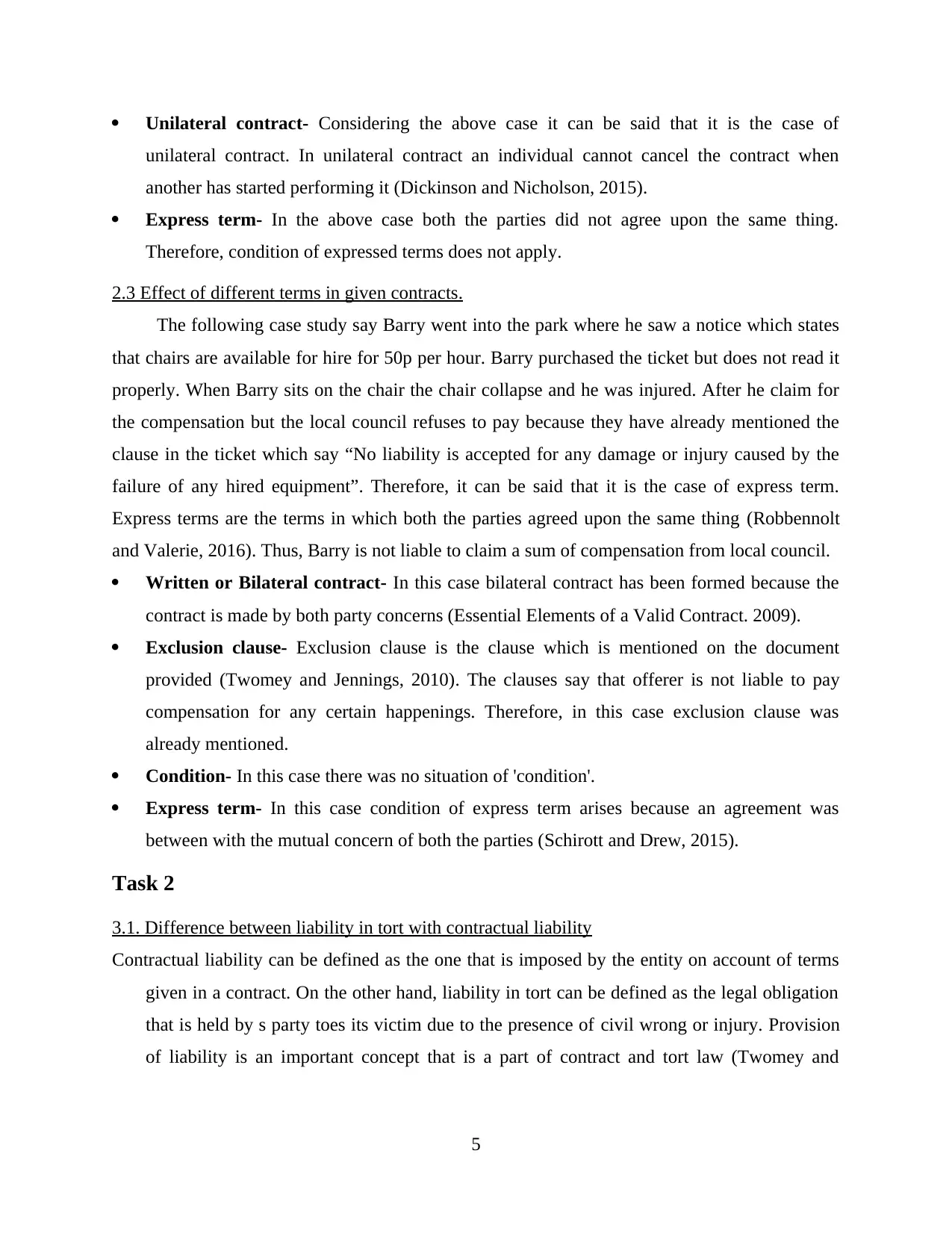
Unilateral contract- Considering the above case it can be said that it is the case of
unilateral contract. In unilateral contract an individual cannot cancel the contract when
another has started performing it (Dickinson and Nicholson, 2015).
Express term- In the above case both the parties did not agree upon the same thing.
Therefore, condition of expressed terms does not apply.
2.3 Effect of different terms in given contracts.
The following case study say Barry went into the park where he saw a notice which states
that chairs are available for hire for 50p per hour. Barry purchased the ticket but does not read it
properly. When Barry sits on the chair the chair collapse and he was injured. After he claim for
the compensation but the local council refuses to pay because they have already mentioned the
clause in the ticket which say “No liability is accepted for any damage or injury caused by the
failure of any hired equipment”. Therefore, it can be said that it is the case of express term.
Express terms are the terms in which both the parties agreed upon the same thing (Robbennolt
and Valerie, 2016). Thus, Barry is not liable to claim a sum of compensation from local council.
Written or Bilateral contract- In this case bilateral contract has been formed because the
contract is made by both party concerns (Essential Elements of a Valid Contract. 2009).
Exclusion clause- Exclusion clause is the clause which is mentioned on the document
provided (Twomey and Jennings, 2010). The clauses say that offerer is not liable to pay
compensation for any certain happenings. Therefore, in this case exclusion clause was
already mentioned.
Condition- In this case there was no situation of 'condition'.
Express term- In this case condition of express term arises because an agreement was
between with the mutual concern of both the parties (Schirott and Drew, 2015).
Task 2
3.1. Difference between liability in tort with contractual liability
Contractual liability can be defined as the one that is imposed by the entity on account of terms
given in a contract. On the other hand, liability in tort can be defined as the legal obligation
that is held by s party toes its victim due to the presence of civil wrong or injury. Provision
of liability is an important concept that is a part of contract and tort law (Twomey and
5
unilateral contract. In unilateral contract an individual cannot cancel the contract when
another has started performing it (Dickinson and Nicholson, 2015).
Express term- In the above case both the parties did not agree upon the same thing.
Therefore, condition of expressed terms does not apply.
2.3 Effect of different terms in given contracts.
The following case study say Barry went into the park where he saw a notice which states
that chairs are available for hire for 50p per hour. Barry purchased the ticket but does not read it
properly. When Barry sits on the chair the chair collapse and he was injured. After he claim for
the compensation but the local council refuses to pay because they have already mentioned the
clause in the ticket which say “No liability is accepted for any damage or injury caused by the
failure of any hired equipment”. Therefore, it can be said that it is the case of express term.
Express terms are the terms in which both the parties agreed upon the same thing (Robbennolt
and Valerie, 2016). Thus, Barry is not liable to claim a sum of compensation from local council.
Written or Bilateral contract- In this case bilateral contract has been formed because the
contract is made by both party concerns (Essential Elements of a Valid Contract. 2009).
Exclusion clause- Exclusion clause is the clause which is mentioned on the document
provided (Twomey and Jennings, 2010). The clauses say that offerer is not liable to pay
compensation for any certain happenings. Therefore, in this case exclusion clause was
already mentioned.
Condition- In this case there was no situation of 'condition'.
Express term- In this case condition of express term arises because an agreement was
between with the mutual concern of both the parties (Schirott and Drew, 2015).
Task 2
3.1. Difference between liability in tort with contractual liability
Contractual liability can be defined as the one that is imposed by the entity on account of terms
given in a contract. On the other hand, liability in tort can be defined as the legal obligation
that is held by s party toes its victim due to the presence of civil wrong or injury. Provision
of liability is an important concept that is a part of contract and tort law (Twomey and
5
Paraphrase This Document
Need a fresh take? Get an instant paraphrase of this document with our AI Paraphraser
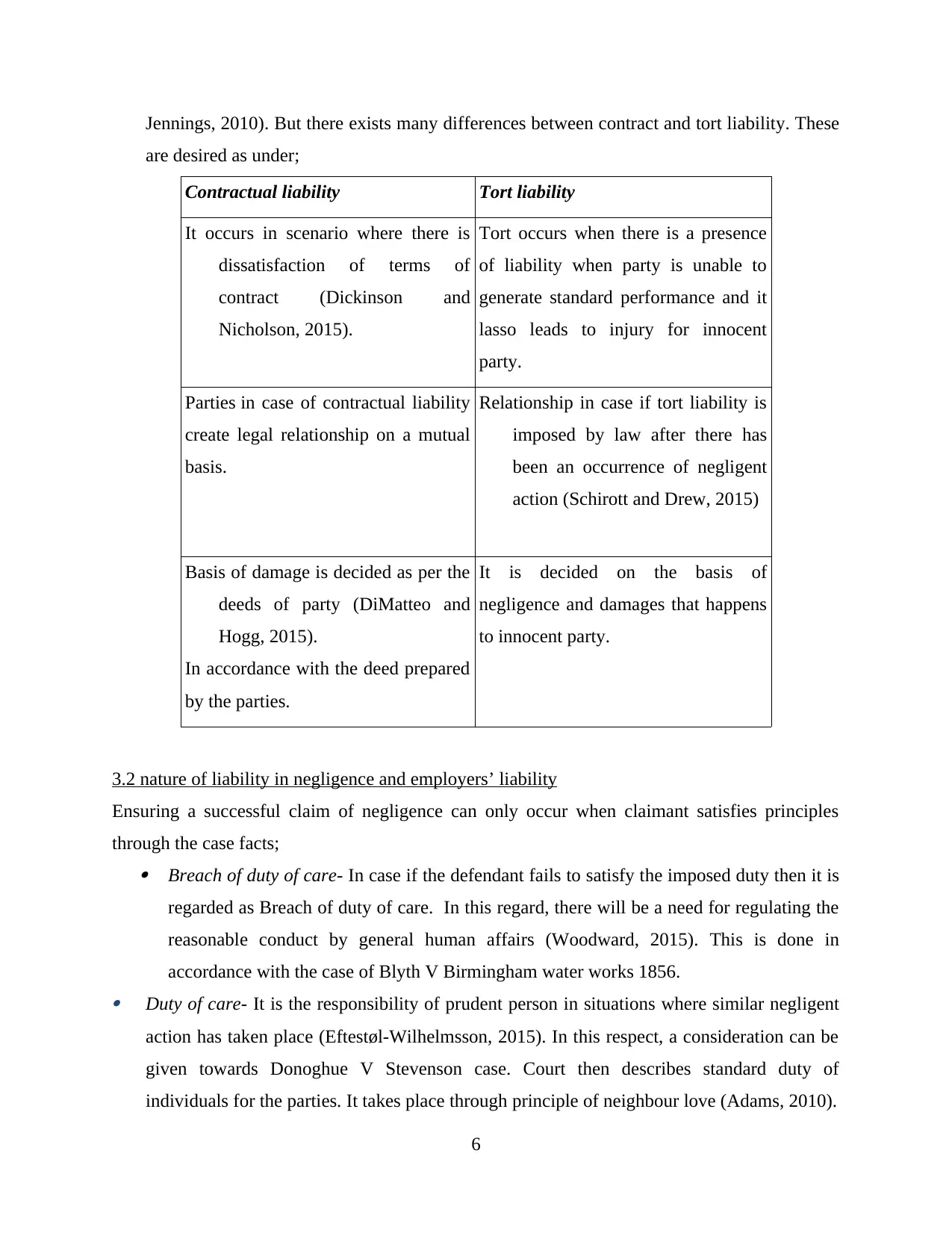
Jennings, 2010). But there exists many differences between contract and tort liability. These
are desired as under;
Contractual liability Tort liability
It occurs in scenario where there is
dissatisfaction of terms of
contract (Dickinson and
Nicholson, 2015).
Tort occurs when there is a presence
of liability when party is unable to
generate standard performance and it
lasso leads to injury for innocent
party.
Parties in case of contractual liability
create legal relationship on a mutual
basis.
Relationship in case if tort liability is
imposed by law after there has
been an occurrence of negligent
action (Schirott and Drew, 2015)
Basis of damage is decided as per the
deeds of party (DiMatteo and
Hogg, 2015).
In accordance with the deed prepared
by the parties.
It is decided on the basis of
negligence and damages that happens
to innocent party.
3.2 nature of liability in negligence and employers’ liability
Ensuring a successful claim of negligence can only occur when claimant satisfies principles
through the case facts; Breach of duty of care- In case if the defendant fails to satisfy the imposed duty then it is
regarded as Breach of duty of care. In this regard, there will be a need for regulating the
reasonable conduct by general human affairs (Woodward, 2015). This is done in
accordance with the case of Blyth V Birmingham water works 1856. Duty of care- It is the responsibility of prudent person in situations where similar negligent
action has taken place (Eftestøl-Wilhelmsson, 2015). In this respect, a consideration can be
given towards Donoghue V Stevenson case. Court then describes standard duty of
individuals for the parties. It takes place through principle of neighbour love (Adams, 2010).
6
are desired as under;
Contractual liability Tort liability
It occurs in scenario where there is
dissatisfaction of terms of
contract (Dickinson and
Nicholson, 2015).
Tort occurs when there is a presence
of liability when party is unable to
generate standard performance and it
lasso leads to injury for innocent
party.
Parties in case of contractual liability
create legal relationship on a mutual
basis.
Relationship in case if tort liability is
imposed by law after there has
been an occurrence of negligent
action (Schirott and Drew, 2015)
Basis of damage is decided as per the
deeds of party (DiMatteo and
Hogg, 2015).
In accordance with the deed prepared
by the parties.
It is decided on the basis of
negligence and damages that happens
to innocent party.
3.2 nature of liability in negligence and employers’ liability
Ensuring a successful claim of negligence can only occur when claimant satisfies principles
through the case facts; Breach of duty of care- In case if the defendant fails to satisfy the imposed duty then it is
regarded as Breach of duty of care. In this regard, there will be a need for regulating the
reasonable conduct by general human affairs (Woodward, 2015). This is done in
accordance with the case of Blyth V Birmingham water works 1856. Duty of care- It is the responsibility of prudent person in situations where similar negligent
action has taken place (Eftestøl-Wilhelmsson, 2015). In this respect, a consideration can be
given towards Donoghue V Stevenson case. Court then describes standard duty of
individuals for the parties. It takes place through principle of neighbour love (Adams, 2010).
6
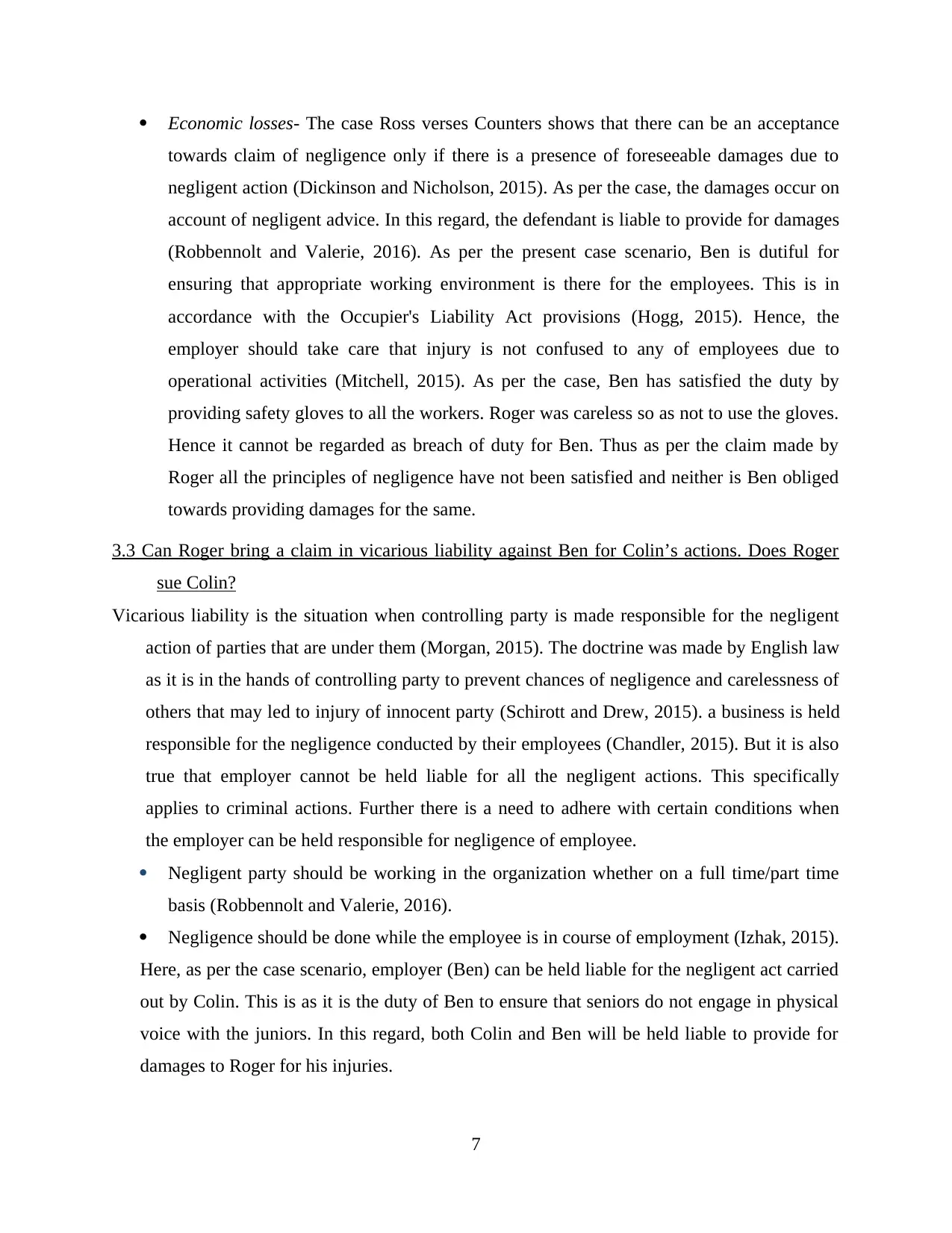
Economic losses- The case Ross verses Counters shows that there can be an acceptance
towards claim of negligence only if there is a presence of foreseeable damages due to
negligent action (Dickinson and Nicholson, 2015). As per the case, the damages occur on
account of negligent advice. In this regard, the defendant is liable to provide for damages
(Robbennolt and Valerie, 2016). As per the present case scenario, Ben is dutiful for
ensuring that appropriate working environment is there for the employees. This is in
accordance with the Occupier's Liability Act provisions (Hogg, 2015). Hence, the
employer should take care that injury is not confused to any of employees due to
operational activities (Mitchell, 2015). As per the case, Ben has satisfied the duty by
providing safety gloves to all the workers. Roger was careless so as not to use the gloves.
Hence it cannot be regarded as breach of duty for Ben. Thus as per the claim made by
Roger all the principles of negligence have not been satisfied and neither is Ben obliged
towards providing damages for the same.
3.3 Can Roger bring a claim in vicarious liability against Ben for Colin’s actions. Does Roger
sue Colin?
Vicarious liability is the situation when controlling party is made responsible for the negligent
action of parties that are under them (Morgan, 2015). The doctrine was made by English law
as it is in the hands of controlling party to prevent chances of negligence and carelessness of
others that may led to injury of innocent party (Schirott and Drew, 2015). a business is held
responsible for the negligence conducted by their employees (Chandler, 2015). But it is also
true that employer cannot be held liable for all the negligent actions. This specifically
applies to criminal actions. Further there is a need to adhere with certain conditions when
the employer can be held responsible for negligence of employee.
Negligent party should be working in the organization whether on a full time/part time
basis (Robbennolt and Valerie, 2016).
Negligence should be done while the employee is in course of employment (Izhak, 2015).
Here, as per the case scenario, employer (Ben) can be held liable for the negligent act carried
out by Colin. This is as it is the duty of Ben to ensure that seniors do not engage in physical
voice with the juniors. In this regard, both Colin and Ben will be held liable to provide for
damages to Roger for his injuries.
7
towards claim of negligence only if there is a presence of foreseeable damages due to
negligent action (Dickinson and Nicholson, 2015). As per the case, the damages occur on
account of negligent advice. In this regard, the defendant is liable to provide for damages
(Robbennolt and Valerie, 2016). As per the present case scenario, Ben is dutiful for
ensuring that appropriate working environment is there for the employees. This is in
accordance with the Occupier's Liability Act provisions (Hogg, 2015). Hence, the
employer should take care that injury is not confused to any of employees due to
operational activities (Mitchell, 2015). As per the case, Ben has satisfied the duty by
providing safety gloves to all the workers. Roger was careless so as not to use the gloves.
Hence it cannot be regarded as breach of duty for Ben. Thus as per the claim made by
Roger all the principles of negligence have not been satisfied and neither is Ben obliged
towards providing damages for the same.
3.3 Can Roger bring a claim in vicarious liability against Ben for Colin’s actions. Does Roger
sue Colin?
Vicarious liability is the situation when controlling party is made responsible for the negligent
action of parties that are under them (Morgan, 2015). The doctrine was made by English law
as it is in the hands of controlling party to prevent chances of negligence and carelessness of
others that may led to injury of innocent party (Schirott and Drew, 2015). a business is held
responsible for the negligence conducted by their employees (Chandler, 2015). But it is also
true that employer cannot be held liable for all the negligent actions. This specifically
applies to criminal actions. Further there is a need to adhere with certain conditions when
the employer can be held responsible for negligence of employee.
Negligent party should be working in the organization whether on a full time/part time
basis (Robbennolt and Valerie, 2016).
Negligence should be done while the employee is in course of employment (Izhak, 2015).
Here, as per the case scenario, employer (Ben) can be held liable for the negligent act carried
out by Colin. This is as it is the duty of Ben to ensure that seniors do not engage in physical
voice with the juniors. In this regard, both Colin and Ben will be held liable to provide for
damages to Roger for his injuries.
7
⊘ This is a preview!⊘
Do you want full access?
Subscribe today to unlock all pages.

Trusted by 1+ million students worldwide
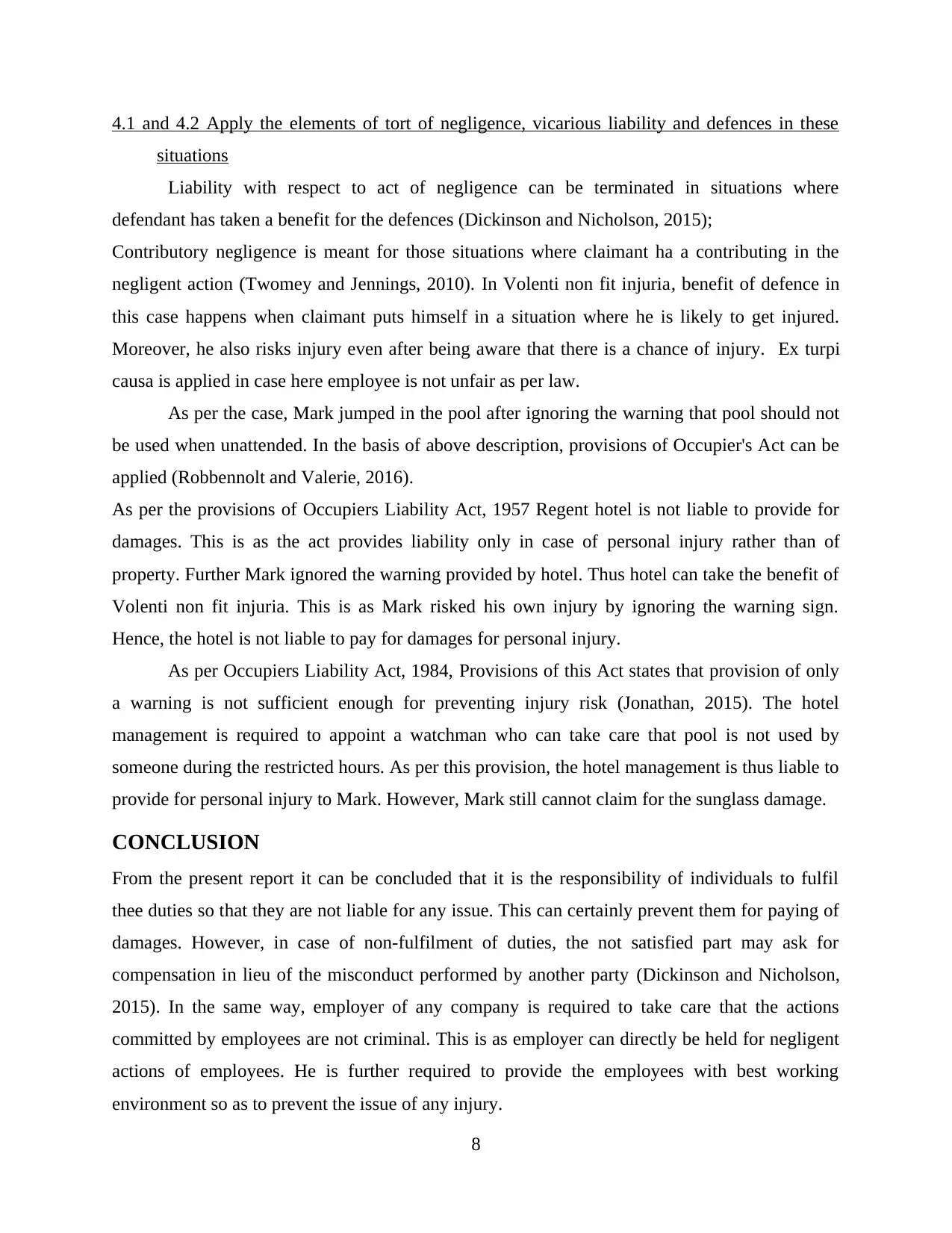
4.1 and 4.2 Apply the elements of tort of negligence, vicarious liability and defences in these
situations
Liability with respect to act of negligence can be terminated in situations where
defendant has taken a benefit for the defences (Dickinson and Nicholson, 2015);
Contributory negligence is meant for those situations where claimant ha a contributing in the
negligent action (Twomey and Jennings, 2010). In Volenti non fit injuria, benefit of defence in
this case happens when claimant puts himself in a situation where he is likely to get injured.
Moreover, he also risks injury even after being aware that there is a chance of injury. Ex turpi
causa is applied in case here employee is not unfair as per law.
As per the case, Mark jumped in the pool after ignoring the warning that pool should not
be used when unattended. In the basis of above description, provisions of Occupier's Act can be
applied (Robbennolt and Valerie, 2016).
As per the provisions of Occupiers Liability Act, 1957 Regent hotel is not liable to provide for
damages. This is as the act provides liability only in case of personal injury rather than of
property. Further Mark ignored the warning provided by hotel. Thus hotel can take the benefit of
Volenti non fit injuria. This is as Mark risked his own injury by ignoring the warning sign.
Hence, the hotel is not liable to pay for damages for personal injury.
As per Occupiers Liability Act, 1984, Provisions of this Act states that provision of only
a warning is not sufficient enough for preventing injury risk (Jonathan, 2015). The hotel
management is required to appoint a watchman who can take care that pool is not used by
someone during the restricted hours. As per this provision, the hotel management is thus liable to
provide for personal injury to Mark. However, Mark still cannot claim for the sunglass damage.
CONCLUSION
From the present report it can be concluded that it is the responsibility of individuals to fulfil
thee duties so that they are not liable for any issue. This can certainly prevent them for paying of
damages. However, in case of non-fulfilment of duties, the not satisfied part may ask for
compensation in lieu of the misconduct performed by another party (Dickinson and Nicholson,
2015). In the same way, employer of any company is required to take care that the actions
committed by employees are not criminal. This is as employer can directly be held for negligent
actions of employees. He is further required to provide the employees with best working
environment so as to prevent the issue of any injury.
8
situations
Liability with respect to act of negligence can be terminated in situations where
defendant has taken a benefit for the defences (Dickinson and Nicholson, 2015);
Contributory negligence is meant for those situations where claimant ha a contributing in the
negligent action (Twomey and Jennings, 2010). In Volenti non fit injuria, benefit of defence in
this case happens when claimant puts himself in a situation where he is likely to get injured.
Moreover, he also risks injury even after being aware that there is a chance of injury. Ex turpi
causa is applied in case here employee is not unfair as per law.
As per the case, Mark jumped in the pool after ignoring the warning that pool should not
be used when unattended. In the basis of above description, provisions of Occupier's Act can be
applied (Robbennolt and Valerie, 2016).
As per the provisions of Occupiers Liability Act, 1957 Regent hotel is not liable to provide for
damages. This is as the act provides liability only in case of personal injury rather than of
property. Further Mark ignored the warning provided by hotel. Thus hotel can take the benefit of
Volenti non fit injuria. This is as Mark risked his own injury by ignoring the warning sign.
Hence, the hotel is not liable to pay for damages for personal injury.
As per Occupiers Liability Act, 1984, Provisions of this Act states that provision of only
a warning is not sufficient enough for preventing injury risk (Jonathan, 2015). The hotel
management is required to appoint a watchman who can take care that pool is not used by
someone during the restricted hours. As per this provision, the hotel management is thus liable to
provide for personal injury to Mark. However, Mark still cannot claim for the sunglass damage.
CONCLUSION
From the present report it can be concluded that it is the responsibility of individuals to fulfil
thee duties so that they are not liable for any issue. This can certainly prevent them for paying of
damages. However, in case of non-fulfilment of duties, the not satisfied part may ask for
compensation in lieu of the misconduct performed by another party (Dickinson and Nicholson,
2015). In the same way, employer of any company is required to take care that the actions
committed by employees are not criminal. This is as employer can directly be held for negligent
actions of employees. He is further required to provide the employees with best working
environment so as to prevent the issue of any injury.
8
Paraphrase This Document
Need a fresh take? Get an instant paraphrase of this document with our AI Paraphraser

9
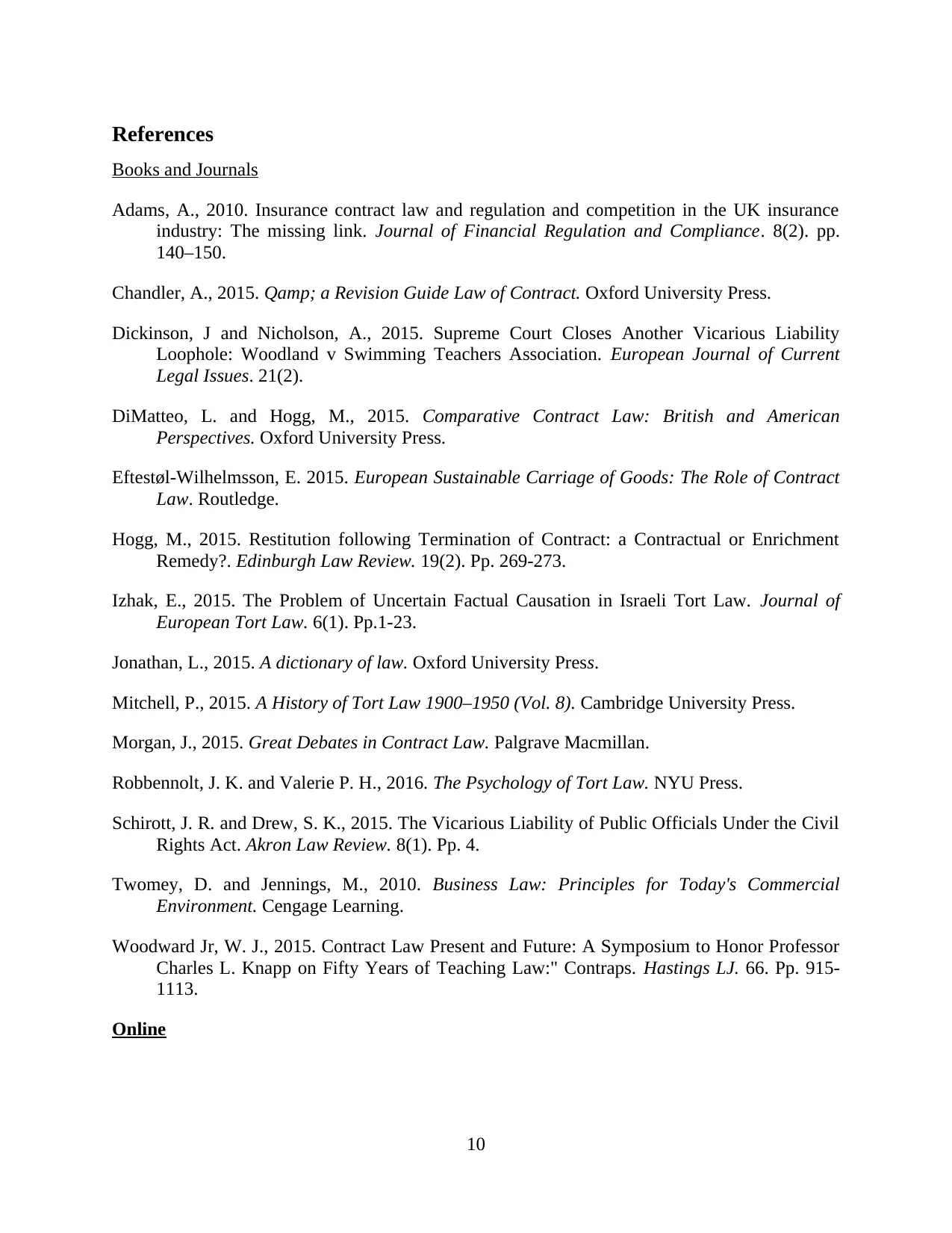
References
Books and Journals
Adams, A., 2010. Insurance contract law and regulation and competition in the UK insurance
industry: The missing link. Journal of Financial Regulation and Compliance. 8(2). pp.
140–150.
Chandler, A., 2015. Qamp; a Revision Guide Law of Contract. Oxford University Press.
Dickinson, J and Nicholson, A., 2015. Supreme Court Closes Another Vicarious Liability
Loophole: Woodland v Swimming Teachers Association. European Journal of Current
Legal Issues. 21(2).
DiMatteo, L. and Hogg, M., 2015. Comparative Contract Law: British and American
Perspectives. Oxford University Press.
Eftestøl-Wilhelmsson, E. 2015. European Sustainable Carriage of Goods: The Role of Contract
Law. Routledge.
Hogg, M., 2015. Restitution following Termination of Contract: a Contractual or Enrichment
Remedy?. Edinburgh Law Review. 19(2). Pp. 269-273.
Izhak, E., 2015. The Problem of Uncertain Factual Causation in Israeli Tort Law. Journal of
European Tort Law. 6(1). Pp.1-23.
Jonathan, L., 2015. A dictionary of law. Oxford University Press.
Mitchell, P., 2015. A History of Tort Law 1900–1950 (Vol. 8). Cambridge University Press.
Morgan, J., 2015. Great Debates in Contract Law. Palgrave Macmillan.
Robbennolt, J. K. and Valerie P. H., 2016. The Psychology of Tort Law. NYU Press.
Schirott, J. R. and Drew, S. K., 2015. The Vicarious Liability of Public Officials Under the Civil
Rights Act. Akron Law Review. 8(1). Pp. 4.
Twomey, D. and Jennings, M., 2010. Business Law: Principles for Today's Commercial
Environment. Cengage Learning.
Woodward Jr, W. J., 2015. Contract Law Present and Future: A Symposium to Honor Professor
Charles L. Knapp on Fifty Years of Teaching Law:" Contraps. Hastings LJ. 66. Pp. 915-
1113.
Online
10
Books and Journals
Adams, A., 2010. Insurance contract law and regulation and competition in the UK insurance
industry: The missing link. Journal of Financial Regulation and Compliance. 8(2). pp.
140–150.
Chandler, A., 2015. Qamp; a Revision Guide Law of Contract. Oxford University Press.
Dickinson, J and Nicholson, A., 2015. Supreme Court Closes Another Vicarious Liability
Loophole: Woodland v Swimming Teachers Association. European Journal of Current
Legal Issues. 21(2).
DiMatteo, L. and Hogg, M., 2015. Comparative Contract Law: British and American
Perspectives. Oxford University Press.
Eftestøl-Wilhelmsson, E. 2015. European Sustainable Carriage of Goods: The Role of Contract
Law. Routledge.
Hogg, M., 2015. Restitution following Termination of Contract: a Contractual or Enrichment
Remedy?. Edinburgh Law Review. 19(2). Pp. 269-273.
Izhak, E., 2015. The Problem of Uncertain Factual Causation in Israeli Tort Law. Journal of
European Tort Law. 6(1). Pp.1-23.
Jonathan, L., 2015. A dictionary of law. Oxford University Press.
Mitchell, P., 2015. A History of Tort Law 1900–1950 (Vol. 8). Cambridge University Press.
Morgan, J., 2015. Great Debates in Contract Law. Palgrave Macmillan.
Robbennolt, J. K. and Valerie P. H., 2016. The Psychology of Tort Law. NYU Press.
Schirott, J. R. and Drew, S. K., 2015. The Vicarious Liability of Public Officials Under the Civil
Rights Act. Akron Law Review. 8(1). Pp. 4.
Twomey, D. and Jennings, M., 2010. Business Law: Principles for Today's Commercial
Environment. Cengage Learning.
Woodward Jr, W. J., 2015. Contract Law Present and Future: A Symposium to Honor Professor
Charles L. Knapp on Fifty Years of Teaching Law:" Contraps. Hastings LJ. 66. Pp. 915-
1113.
Online
10
⊘ This is a preview!⊘
Do you want full access?
Subscribe today to unlock all pages.

Trusted by 1+ million students worldwide
1 out of 12
Related Documents
Your All-in-One AI-Powered Toolkit for Academic Success.
+13062052269
info@desklib.com
Available 24*7 on WhatsApp / Email
![[object Object]](/_next/static/media/star-bottom.7253800d.svg)
Unlock your academic potential
Copyright © 2020–2025 A2Z Services. All Rights Reserved. Developed and managed by ZUCOL.





